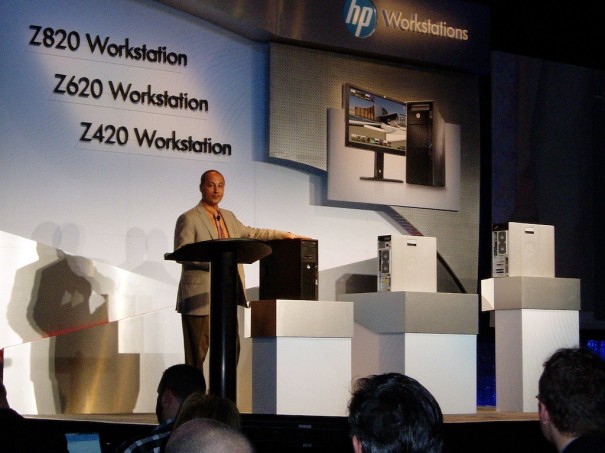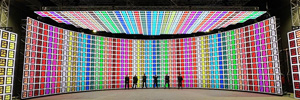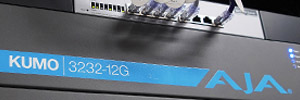Jim Zafarana: “la serie Z de HP responde mejor que cualquier otra a las necesidades de gráficos HD y 3D”
El vicepresidente y gerente general de la unidad de negocio de soluciones comerciales de HP analiza en esta entrevista con Panorama Audiovisual la actual situación del mercado de workstation, su potencial de crecimiento y las posibilidades que para el mercado broadcast y postproducción ofrecen las nuevas estaciones de HP.
HP ha potenciado su línea Z de workstations desktops con cuatro nuevos modelos con los que reinventa esta categoría, dotándole de un renovado diseño y añadiéndole más potencia, desde la alimentación a la placa base. Así, la HP Z820, la HP Z620, la HP Z420 y la Z1 –la primera workstation todo-en-uno del mundo- incorporan las ventajas que proporcionan los procesadores Intel Xeon y las tarjetas gráficas Quadro de Nvidia. El vicepresidente y gerente general de la unidad de negocio de soluciones comerciales de HP, Jim Zafarana, nos desvela en esta entrevista los principales detalles de la nueva gama de estaciones de trabajo de la multinacional de Silicon Valley.
¿Cuál es la situación actual del mercado de workstations?
El mercado de las workstations tiene dos partes: las estaciones de trabajo de escritorio y las estaciones de trabajo móviles. Ambas han experimentado un crecimiento muy rápido en los últimos años. En concreto, las estaciones de trabajo de escritorio representan alrededor del 74 o 75% del mercado en valor unitario y las estaciones de trabajo móviles el resto.
El mercado a nivel mundial ha estado creciendo en los últimos años en torno a un 18% anual en valor unitario, un crecimiento que ha sido muy saludable e incluso más rápido que el del mercado de PCs convencionales. HP se ha convertido en una parte importante del mercado, con un crecimiento más rápido que la media del sector en general, dos o tres veces más rápido.
Acabamos de recibir los resultados del 4º trimestre de 2011. Por primera vez en la historia de esta industria, hemos superado el 50% de cuota de mercado tanto en workstations desktops como en móviles, así como en el total. Eso incluye también a Europa Oriental y Occidental, Oriente Medio y África, lo que implica que somos fuertes en todas partes.
¿Qué distingue a HP del resto de sus competidores?
El hecho de contar con un gran portfolio de productos y una gran estructura organizativa. Nuestros clientes nos dicen que contamos con la mejor calidad. Estamos tratando de potenciar la industria, para que las workstations sean muy configurables, muy útiles. Estamos proporcionando a nuestros clientes las herramientas para que hagan lo que tienen que hacer en un entorno profesional.
Hemos diseñado la línea Z1 para el usuario profesional. Decidimos que no íbamos a construir un producto de tecnología de consumo, sino un producto profesional. Nos centramos en las aplicaciones profesionales. Cuando se piensa de esa manera, hay que pensar que Adobe ha optimizado el software para gráficos de Nvidia, por lo que tiene Autodesk. Para aquellos usuarios que necesitan fiabilidad, nos decidimos por la memoria ECC y los chips de Intel Xeon, que le dan esa ventaja de rendimiento. Estos usuarios también necesitan un alto rendimiento, acceso a disco de alta fiabilidad, así que pusimos una configuración RAID. Tienen que grabar discos Blu-DVD en tiempo real, así que pusimos Blu-Ray. Los ingenieros de sonido profesionales quieren sonido profesional, por lo que agregamos esa capacidad.
¿Qué importancia tiene el I+D en el área de workstations de HP?
Mucha. El primer paso es llevar a cabo la investigación para la toma de decisiones de un determinado proyecto en una serie de entrevistas con nuestros clientes de los distintos mercados, en todas las industrias a nivel mundial. Escuchamos a nuestros clientes e integramos la información recopilada, y luego llevamos a cabo proyectos innovadores sobre la base de esta información.
En la serie Z de productos, pasamos dos años haciendo esta investigación, y entendimos la situación del mercado. Como todos sabemos, la carga de trabajo de los clientes de workstations es muy grande, pueden tener que trabajar durante varios meses con aplicaciones tales como gráficos de alta calidad, 3D, etc., y la línea de productos de la serie Z de HP responde mejor que cualquier otra a esas necesidades. HP desea crear valor para sus clientes, para construir una sólida plataforma para ayudarles a lograr la estandarización global de sus operaciones
Una característica distintiva de las estaciones de trabajo de HP es la medida en que se desarrollan en asociación con los proveedores de componentes. Parte de la fortaleza de esas alianzas es que a nivel técnico, es una relación de iguales. Hace treinta años no teníamos los componentes estándar, hemos tenido que desarrollar nuestra propia CPU, controladores de gráficos, placas base, el chasis… Este es un negocio vertical que exige una inversión muy alta.
Cuando la industria se movió, e Intel, Nvidia y Microsoft entraron en el mercado, pudimos desarrollar nuestro negocio. Contamos con un equipo que sabe cómo funciona todo, así que cuando estamos trabajando con Nvidia, tengo a alguien de mi equipo que trabaja de igual a igual con Nvidia, y tiene un conocimiento profundo del tema gráfico. Hacemos pruebas con aplicaciones en una tarjeta gráfica, y somos capaces de ofrecerle un ‘feedback’ a Nvidia seis meses antes de que lancen la tarjeta. Y lo mismo pasa con Intel.
Si le preguntas a ambas compañías cuál es su socio tecnológico con un conocimiento técnico más profundo, te van a decir que es mi equipo. Tengo una gente muy competente aquí, que han pasado por muchas transiciones, muchas tecnologías, y creo que eso se nota en los productos.
¿Cuáles son las principales características de las nuevas workstations para la industria broadscast y qué ventajas proporcionan a los profesionales de este sector?
La nueva línea Z de workstations HP es totalmente funcional, desde la fuente de alimentación hasta la placa base. Los efectos multiplicadores del procesamiento multinúcleo en las workstations de HP son transformadores, ya que convierten horas en segundos, días en minutos, y años en trimestres.
Los primeros estudios muestran que una HP Z puede recuperar la inversión realizada en un periodo sorprendentemente corto gracias a las ganancias de desempeño y productividad. El diseño de las workstations es totalmente modular, pueden montarse y desmontarse sin utilizar el destornillador y en ellas no se ve ni un solo cable.
HP está comprometida con el suministro a nuestros clientes de soluciones gráficas líderes en el mercado. Los broadcasters buscan cada vez unas mayores prestaciones en el ámbito de la alta definición y el desarrollo de gráficos es un área en la que las estaciones de trabajo de HP tienen una clara ventaja sobre la competencia. Conforme más profesionales demanden mayor poder gráfico para las aplicaciones más exigentes, se darán cuenta que necesitan gran rendimiento en render y gráficos 3D. Los gráficos Nvidia Quadro brindan mejores capacidades de visualización para los profesionales creativos con nuestras nuevas workstations.
HP es proveedor de sistemas de muchas de las empresas de animación y efectos especiales de Hollywood, como Dreamworks Animation, Weta Digital o Industrial Light and Magic, que emplean las workstations de HP para conseguir imágenes increíbles, que parecen reales. ¿Qué podemos esperar de cara al futuro? ¿Hasta dónde pueden llegar?
Más lejos. Es evidente que en la industria broadcast se va a continuar realizando una combinación de efectos visuales, gráficos y aplicaciones 3D para obtener unas imágenes cada vez más realistas en las películas.
Con la actual situación de crisis o recesión económica que estamos atravesando, ¿qué perspectivas de futuro ve para el mercado de las workstations en los próximos años?
HP ha decidido completar la actualización de su línea de productos de la serie Z de workstations desktop en este momento, en un entorno económico muy difícil, comprometiéndose a mejorar sus productos y servicios. La situación actual es bastante inestable, pero creo que va a mejorar. Creo que la demanda de estaciones de trabajo se va a incrementar, e incluso en períodos de crisis financiera, siempre hay áreas críticas de trabajo como salud, diseño, análisis, desarrollo y producción de entretenimiento que necesitan workstations. La forma de mejorar o de crecer en el mercado es a través de la innovación.
Did you like this article?
Subscribe to us RSS feed And you will not miss anything.

















